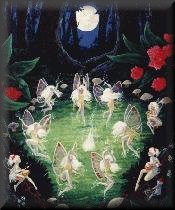|
|
|

In many traditions, the Wheel of the Year begins at Samhain. Here begins the year's darkest time, midway between the autumn equinox and the winter solstice. It is a time when the spirit world is close to the world of the living, and the veil between the two is thin. For this reason Witches celebrate the Samhain sabbot by inviting the spirits of the deceased to join us. The circle may be decorated with pumpkins, gourds, and autumn leaves, especially oak leaves that symbolize the Lord of Death. The Candles at the four directions might be placed in jack-o-lanterns and a "gateway" left at the western point--the direction of death--through which the dead may enter. The spirits are invited during the rite, which may include a spiral dance, danced counter-clockwise (widdershins), symbolic of rebirth. At Samhain Witches hope to recieve messages not only from deceased loved ones, but from predecessors in the Craft, their Pagan ancestors or kindred spirits. This is also the time for predicting the future by casting runes or reading tarot cards. The Goddess is honored in her aspect as The Crone, the Goddess of the Dark Mysteries. The God is honored in his aspect as the Horned God of the Dead, not only of humans but of animals as well.
Falling on December 21, the winter solstice, is the next sabbot Yule. The days begin growing longer and the dark peiod begins to lessen. To Witches, now comes the birth of the Divine Child, the new solar year. The Yule circle might be adourned with holly and oak, symbolic of the waning and waxing Sun. A Yule log is traditionally burned and its ashes kept as amulets of protection and fertility. The God is honored in his aspect as Divine Child and the Goddess as the Divine Mother.
On the night of February 1 or 2, Witches celebrate the Imbolc sabbat. This night, halfway between the winter solstice and the spring equinox is the time when Nature begins to stir unseen and awaken from winter's death-like sleep. The circle might be adorned with white flowers, snowdrops, Christmas roses, or paper whites--or not adorned at all, symbolizing Natures apparent barreness at this time. The ritual might include lighting many candles to symbolize the Sun's increasing light. Many Witches perform a rite called "Bride's Bed" which consists of dressing a doll made with corn or other grain and placing it in a basket with a wand representing the God. The Goddess is honored at this sabbat as the Corn Maiden and the God is honored as the Spirit Father.
On or about March 21 Witches celebrate the spring equinox, sometimes called Ostara. This is the time when night and day, dark and light, are equal and the light begins to grow greater than dark. The circle might be decorated with spring flowers--daffodils, tulips, hycinths, pussy willows--or bowls and baskets of colored eggs. This is the time for the ritual blessing of seeds, and as they did in ancient times, Witches make offerings to the Goddess with colored eggs and cakes, sometimes inscribed with solar crosses. At this sabbat the Goddess is honored in her aspect as the Maiden and the God as her brother/ consort the Sun God.
The eve of May 1 is Beltaine, along with Samhain one of the most sacred days in the Witch's calander. The circle is decorated with spring flowers, easpecially wild ones. During the ritual a May Queen is crowned with a chaplet of flowers and a May King is crowned with a wreath of green leaves. A Maypole, symbolizing the phallus that gives the spark of life, is danced around and entwined with ribbons, while a fire made with nine woods is kindled to celebrate the strengthening of the Sun. The Goddess is honored at Beltaine in her aspect as the White Goddess of Fertility and the God as the Lord of the Greenwood. Beltaine is the celebration of the Divine Marriage.
On about June 21, the longest day of the year, is the celebration of Midsummer, the summer solstice. Magickal herbs such as St. John's Wart ans vervain are traditionally gathered now. The circle might be adorned with summer flowers--sunflowers are ideal. On this day bonfires are lit to celebrate the Sun at the peak of its power. Witches leap over the flames and make amulets of rowan or rue to hang in homes and barns for the protection of animals. The God is honored in his aspect as the Sun God and the Goddess as the Earth Mother.
The eve of August 1 is Lammas, the celebration of the first harvest. The circle is adorned with ears of corn, baskets of vegetables and reaping tools. The ritual itself is a thanksgiving for the harvest, particularly the grain harvest, and the ritual eating and sharing of bread and wine is the sabbots main theme. At Lammas Witches honor the Goddess in her aspect as all-providing Eart Mother, Grain Goddess or Corn Mother, and the God is honored as the sacrificed God of Grain.
September 21 is the autumn equinox when day and night are equal, and the hours of the night begin to grow longer than those of day. The circle is adorned with autumn leaves, seed pods and fall fruits. Witches prepare to bid farewell to the Maiden of Spring and the Mother of Summer, and as Nature prepares for the death-like sleep of winter, Witches welcome the Crone and honor the God of the dying Sun, the God of death and rebirth.
***************************************************************** From the book "Witchcraft Today" Article by Pauline Campanelli *****************************************************************
I Am A Proud Member Of:

Phenomenal Women Of The Web